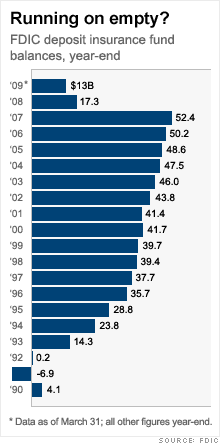Bad banks -- They're baaack!
Seeking to lure more buyers at a time of intense distress, the FDIC has dusted off the oft-touted, but rarely used, plan of setting up bad banks. Will it work this time?
 |
| The FDIC, led by Sheila Bair, is trying to push failed bank assets back into the private sector. |

NEW YORK (Fortune) -- Facing mounting bank failures, regulators are putting a new twist on a familiar idea: splitting a bank's good assets from the bad ones.
The Federal Deposit Insurance Corp. said last month it would consider splitting the toxic assets of a failed bank from its more valuable parts, such as deposits and loans that aren't going sour.
The goal is to help the FDIC, facing the biggest wave of bank failures in almost two decades, find new buyers for the remains of failed banks while limiting losses on its depleted insurance fund.
"This helps us widen the net in marketing bank assets," said FDIC spokesman David Barr. "When you have the inventory we have, you look for different ways to try to sell it."
Thanks to the ill effects of the housing bubble, the FDIC certainly has the inventory. Barr said the FDIC had $26.5 billion in assets in liquidation at the end of July, with two-thirds of that in mortgages and real estate-backed securities.
Though the FDIC says it's having success in finding buyers for much of these assets, it is also trying to find ways to move inventory at better prices. In one program, the agency will provide financing to acquirers of troubled loans.
"There has been little activity in sales of whole loans," said Hal Reichwald, a lawyer at Manatt Phelps & Phillips in Los Angeles who represents investors. "The danger is you could end up with a bottleneck in the distressed asset markets."
When a bank is on the verge of collapse, the FDIC typically tries to find buyers for the entire bank at once, often with the help of deals in which the agency shares losses on the failed bank's bad loans.
Friday's failure of Alabama's Colonial BancGroup is one such deal: buyer BB&T (BBT, Fortune 500) took on most of Colonial's $25 billion in assets, with it and the FDIC sharing losses on two-thirds of that pool. Some $3 billion of assets will remain with the FDIC for later disposition, the agency said in a statement Friday.
But with banks failing at a clip not seen since the late stages of the savings and loan crisis in the early 1990s, finding a buyer for the whole bank isn't always possible.
So far in 2009, 77 banks have failed -- more than triple the 2008 toll. The FDIC has taken on some assets in many of those deals, and it has failed to find takers of any kind for six banks -- including the giant correspondent bank Silverton, which went under in April with $4.1 billion in assets.
In a more recent case, the FDIC couldn't find a buyer for a small bank in Georgia, even after contacting 300 potential buyers.
The wave of failures and resulting soft demand have left the FDIC weighing the benefits of attracting new capital to shore up failed banks against the risks of allowing private equity investors, which typically use a lot of debt to finance deals, to become more active buyers.
Last November, the FDIC issued rules expanding the field of bidders for troubled bank assets. But last month it proposed holding private investors to higher capital standards and imposing a waiting period that would keep buyout firms from "flipping" banks.
"The question is real equity vs. borrowed equity," said James Angel, a finance professor at Georgetown University. "The temptation is to lever yourself up to your eyeballs, and that's something the FDIC has to be on guard against."
How the agency decides to treat private equity buyers could go a long way toward deciding whether the bad-bank plan succeeds.
That said, the FDIC's approach marks the first time during the financial crisis that the bad-bank concept has been considered as something other than a Hail Mary pass.
Lehman Brothers proposed a split last September to rid itself of its troubled commercial real estate assets, in a desperate bid to restore market confidence. Investors rejected the plan as unworkable and the firm filed for bankruptcy just days later.
Since then, the government has toyed with variations on good-bank/bad-bank plans for healthy institutions at least twice. The first was former Treasury Secretary Hank Paulson's original plan for the Troubled Asset Relief Program. Then there was discussion of a so-called aggregator bank by the Obama administration.
But those plans foundered due to questions of how the bad assets would be valued and how the already capital-constrained banks getting rid of those assets would make up for the resulting losses.
That isn't a problem for the FDIC. As the receiver of failed banks, it takes possession of the assets itself.
Still, bankers expect to continue struggling with the issue of how much to pay for bad assets for some time -- even though a robust bank stock rally over the past five months suggests investors are less worried about toxic assets than they once were.
"There are a ton of toxic assets out there right now," said Norman Skalicky, CEO of Stearns Bank, a St. Cloud, Minn.-based lender that has bought several banks and a $730 million loan portfolio from the FDIC over the past year. "But then, they say there are no toxic assets -- just toxic prices." ![]()
-
 The retail giant tops the Fortune 500 for the second year in a row. Who else made the list? More
The retail giant tops the Fortune 500 for the second year in a row. Who else made the list? More -
 This group of companies is all about social networking to connect with their customers. More
This group of companies is all about social networking to connect with their customers. More -
 The fight over the cholesterol medication is keeping a generic version from hitting the market. More
The fight over the cholesterol medication is keeping a generic version from hitting the market. More -
 Bin Laden may be dead, but the terrorist group he led doesn't need his money. More
Bin Laden may be dead, but the terrorist group he led doesn't need his money. More -
 U.S. real estate might be a mess, but in other parts of the world, home prices are jumping. More
U.S. real estate might be a mess, but in other parts of the world, home prices are jumping. More -
 Libya's output is a fraction of global production, but it's crucial to the nation's economy. More
Libya's output is a fraction of global production, but it's crucial to the nation's economy. More -
 Once rates start to rise, things could get ugly fast for our neighbors to the north. More
Once rates start to rise, things could get ugly fast for our neighbors to the north. More







